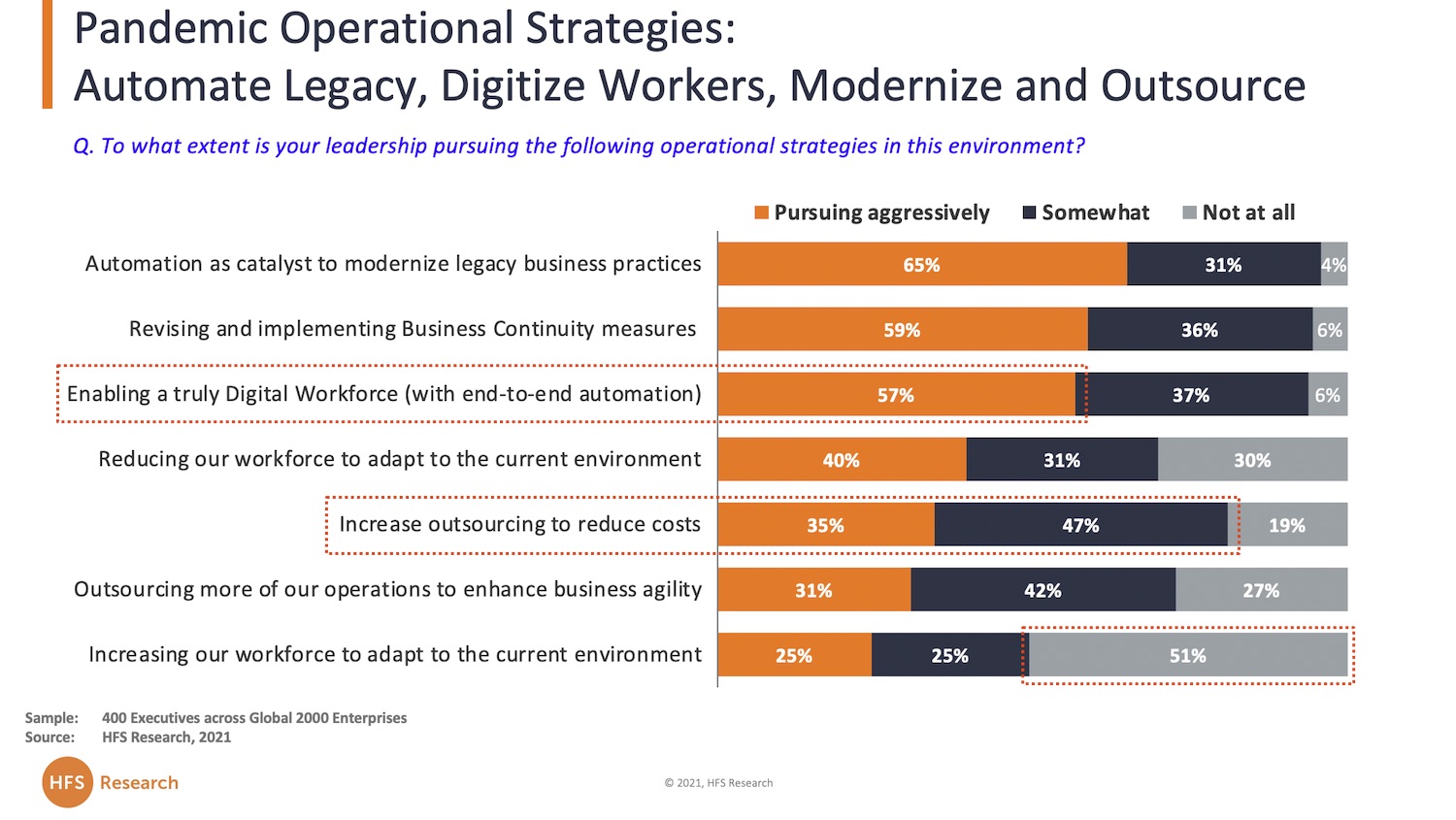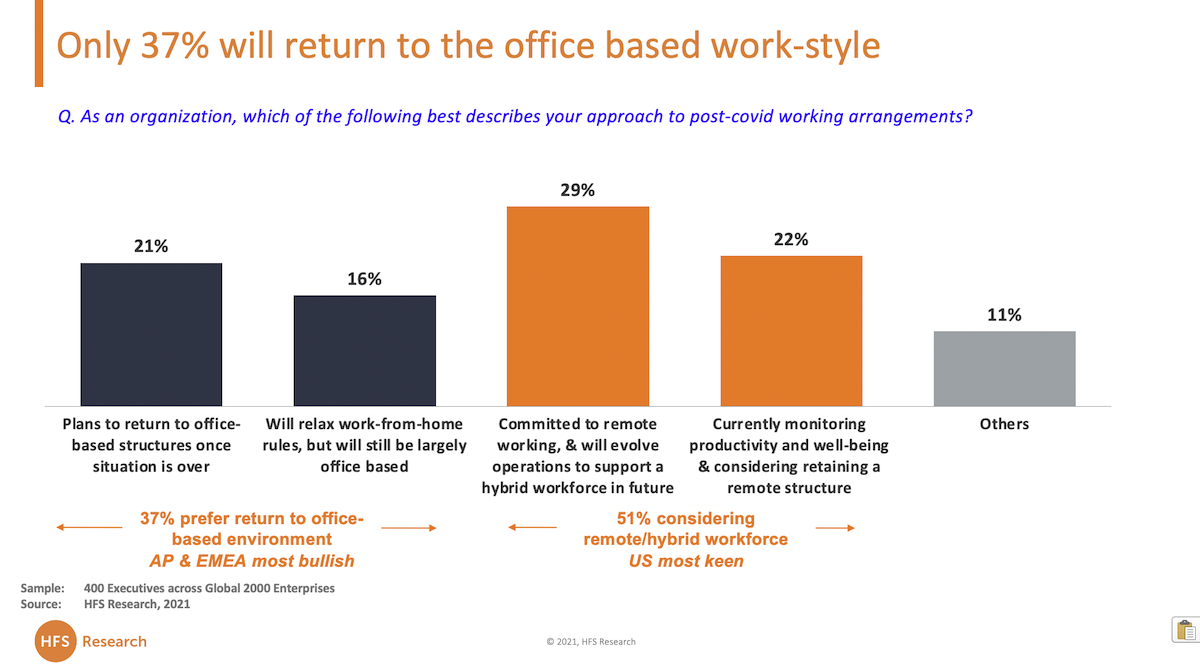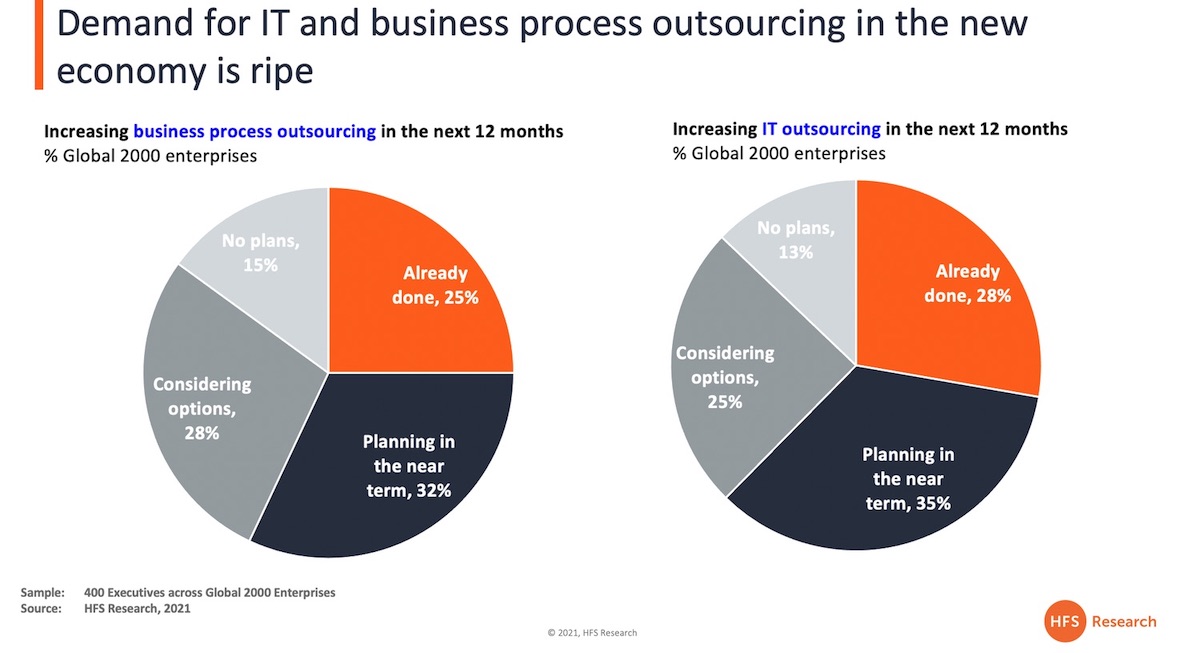The impact of the pandemic has completely changed the mindset and change imperative of the majority of organizations. Our recent study of 400 operations and IT leaders across the Global 2000 shows how crucial automation has become as the catalyst to modernize business operations. And this means the old-thinking around RPA is rapidly leaving the building, as enterprises are faced with a dual challenge: ring-fencing legacy data centers and processes, while making fresh investments to re-jig critical processes to function effectively in the cloud:
Simply put, if you try to take your existing messy processes and simply move them “as-is” into a cloud environment, it’s going to be one very costly exercise that could be so cumbersome, you may go out of business before you even get them there. We used to talk a lot, in pre-Covid days, about moving your “mess for less” offshore, and even if you did very limited transformation, you would reduce costs simply because you were tasking lower-cost people to run them for you. Essentially, anything you couldn’t shoe-horn into your standard ERP model would be a prime candidate to outsource as it was not likely to be core business activity, but you still needed them processed, and you might as well run your mess for cheaper via a service partner, than do it yourself.
Two thirds of major enterprises have no choice but to head for the Cloud in the new economy
Fast-forward to 2021, and most large enterprises have managed to move their messy stuff to an outsourcer or their offshore captive. That was what legacy outsourcing was all about and over 90% of the Global 2000 did it. Now they are faced with a whole set of nagging new challenges, as they simply have to function in the cloud, if they want to be effective in this work-from-anywhere environment, which we know is going to be the norm for at least two-thirds of enterprises, even after we finally get Covid under control:
So what does this new wave of outsourcing look like, and why is it poised to increase at close to 10% this year – and likely even more next year?
The desire to centralize large clusters of people is dissipating with enterprise leaders focused on outcomes. After 14 months of operating with armies of shared service staff operating remotely, most have learned how to manage by focusing on the outcomes of getting processes delivered, as opposed to obsessing with governance structures based on effort and control. Many enterprise leaders have told us how they are focused on driving greater internal coordination with increased daily video meetings, where accountability and ownership are determinedly applied, and 51% (see above) do not see the need to add additional headcount to make this happen.
The need to scale-up and scale-down at speed has never been more pronounced. The number one watch-word today is about moving at speed. Enterprise leaders accepting the current status quo simply want to make fast decisions to make their operations and supply chains as nimble as possible. This means freeing themselves from multiple sign-off points to enact policies and strategies is becoming an imperative; lugging around bloated back office functions that strangle the ability to get things done is becoming a tainted memory. Having deeper partnerships with lesser numbers of partners not only cuts out operational costs, but also creates far more flexibility to operate at speed in unpredictable market conditions. This explains why a quarter of enterprises have already increased their outsourcing scope across business and IT processes in this environment, and a further third are planning to accelerate in the near term. Pipelines for new deals are strong – especially in Europe, and early indications from our soon-to-be-finalized Pulse study for H1 2021 indicate expenditure increase in the high single-digits:
The need to add “digitally-fluent capability” is forcing the issue on the interplay between business context and technology capability. With all today’s technology solutions CIOs are evaluating being cloud-based, their roles are shifting away from the provision of custom-app development, support and maintenance etc., and towards understanding the business context of their non-IT executive counterparts. This is more about housing data, ensuring security, scalability, speed and business continuity. They need to make their departmental leaders’ data ubiquitously available, accessible, and mineable – working with them to embed a mindset that inspires business and IT staff to work together to create an organization that can flip its business model to exploit these seismic market changes.
There is a lot more trust to work with partners. The rapid uptick in deeper, broader outsourcing relationships is being driven by enterprise buyers becoming more decisive and experienced, and their service partners becoming much more adept and confidant to strike rapid, cost-friendly deals, knowing they have the expertise and resources to make these deals profitable in the short term and (potentially) lucrative in the medium-longer term, as they get closer to their customers’ customers.
It’s much easier to have a third-party drive automation than forcing it on resistant/inexperienced staff. Today’s service providers are becoming highly adept at automating transactional work – simply because they have had no choice but to get proficient at it if they are to deliver value for their clients profitably. On the flip-side, enterprises have proven particularly useless at scaling automation projects and doing anything more than piecemeal projects within silos. We can delve into all the reasons why this has been a failure for over 80% of them, such as politics, employee resistance and inability to redesign processes (and let’s not forget a year-plus of pandemic), but the benefits of having an external party tasked with driving your automation efficiencies are now crystal clear.
Bottom-line: With the cyclical nature of global recessions, the historical reaction is to outsource without much transformation. However, the response this time is different…
Today’s service providers are much more confidant at delivering the outcomes because they know how to infuse technology to support these new commercial models. Moreover, you can’t get the data you need if your critical data is not in the cloud and you don’t have the people, partners, processes, technology – and desire to change – to make this possible. Service providers now have the experience, desire and risk-appetite to roll their sleeves up and help many enterprises make it through the most unpredictable economic era we have ever lived through.
Posted in : Business Process Outsourcing (BPO), Cloud Computing, IT Outsourcing / IT Services, OneOffice









